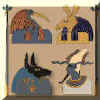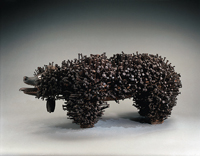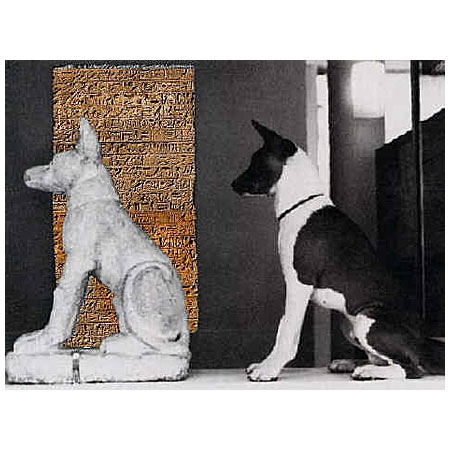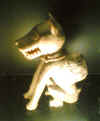MuseumS and Culture

We are lastly in Torino, enter the Egyptian Museum, the Science Academy Palace, the most important one in the world after that of Cairo, one of the most ancient (founded in 1824). Inside there is the Drovetti collection, a famous Napoleon’s soldier during the campaign in Egypt. It was just Jean Francois Champollion, the genius who in a couple of years made out hieroglyphs, who listed and settled 100 statues, 170 papyri, stones, sarcophagi, their mummies and a lot of things that were daily used in the ancient Egypt and that he brought to Italy.
Because of the many gaps in the datings and in the references to the excavations, Louvre Museum in Paris (with a second Drovetti collection), British Museum in London and other ones, owning less stuff but listed in a better way, were considered more important.
In 1894 Mr. Ernesto Schiapparelli, who was already director of the Archaeological Museum in Florence, became director of the museum. Other finds came from Thebe’s area, from Eliopolis, the sacred city of the sun’s god, Ra, from Giza, around the three big pyramids and in a part of the necropolis with graves belonging to officials of the 4th and 5th dinasties, from the Queens’Valley in the Theban necropolis with graves of officials, princes and queen belonging to the New Kingdom (Neferthari’s grave, Ramesse II’s bride, and the three graves of Ramesse II’s children. But also prehistoric, greek and roman graves.
From some years there is a plan of reclassification and study of the excavations made by Schiapparelli from 1905 till 1920, coming back to the Egiptian places in order to give back the proper historical, environmental and scientific value to the stuff owned by the Museum, thinking also of a next place change.
But we must now speak about Basenjis, about dogs in Egipt: there are a lot of references to the jackal, with sharpened ears, crouched or staying with the thick tail falling down. Everybody know about the sacredness of animals in Egipt: there was the death sentence for people who killed either a dog or a cat. There are a lot of mummies in the showcases of the penultimate room of the Museum: a crocodile, a dog-ape, some cats and, low in a corner, even two dog’s mummies.
They are small, having the size and the shape of a skittle and a dogshaped head. The evidence of the presence of Basenjis in the daily Egiptian life was found in the last room. Along all the walls we can see a set of wash drawings on mud and straw plaster: this is the inner part of Iti’s grave and his wife’s, Noferu (11th dinasty - 2200 B.C.). They come from Gebelein, a dusty hill, once upon a time a rich frontier city, at 30 Kms from Thebes, on the left shore of Nile near the southern border and in close touch with the Nubian populations of central Africa. It is a porch grave; Iti was the chief of the army and the king’s treasurer.
The drawn scenes are particularly important as they deal with the funeral ritual and daily life: navigation, carriage of the corn to the barns, hunt. Just in the first of the two images with Basenjis you can see a dog next to a man, rather small, with sharpened ears and the tail curled on the back. The same image, in a different attitude, is drawn in the second picture: for all the other visitors it was a trifling document, but it was for us the proof of a myth found out with our eyes (not only read on the book of a couple of English anthropologists lived at the beginning of this century).
This myth was confirmed for a second time by a second image at the end of the show, in the same grave, representing two much larger dogs, one of which black. That was for us the proof of the existence of the other ancient breed that is known today by the name of Pharaon hound.
From 2 October to the 15 February 2003 the first european historical exibition of African Art at the
Museo
d'Arte Moderna of Torino.
AFRICA:
capolavori da un continente.
We didn't see ancient "basenji" but ...Here a photo to see
"stolen" photos
At the end of June 2004 Lorenzo, owner of Dante and Marte, married: he went in Honeymoon in Egypt.
He sent us 2 "stolen" photos
28 July 2004
African Culture Paris Museums
I went in Paris Museums a lot of time and each travel was a little suprise...
First time I was in the new part of the Louvre (Africa and Oceania).. I saw some wood and steel hand-manufactured from the end of the nineteenth century.

It was a NAILED DOG coming from Congo: almond-shaped eyes and the typical basenji look cought me immediatelly, the open mouthe with pointed tooth and tongue little hanging out, almost a smile... than between the nails, embedded and big, I saw , on the neck a bell. On the back there was a little space to put a plate for offert from wizard to Divinities.. They Use basenjis as a link to the afterlife God...In the bottom, near the back, I saw amog neals, the curly tail.
Here other info on line
I don't know if these manufacted are still visible, or there are someone new, here the site of Louvre Museum.
New basenji from the Past
Another NAILED DOG was in Human Museum of Natural History, very similar in shape to the other I saw but not exactly alike .. I lost him for a few years than recently, I knew of inauguration of theMuseum
of Quai Branly and as soon as possible I went there, hopefully to find it again...
a little disappointed in change of a new discovery:
the munfacted wasn't in the Congo section but I meet something new: a little sitting dog, smiling, with the typical curly tail on the bottom.
a new basenji came from the Past !
Luisa
Here I am, back home from a journey I did not have in mind to do in this life: six days in Japan.
We knew from the beginning that the free time at our disposal would have been short, but when we could have another similar occasion, such a great invite? A lot of hours spent on the plane and we found ourselves in the same Italian weather, a bit more humid, sun light at 4:30 and dark pretty soon. Even when the weather is nice, in Tokyo the sky is always covered by the smog. Most of our days are organized and full of appointments and established engagements. First stop the Pacific Flora in Hamamatsu, a flower and furnish fair that last six months, where my husband’s company has planned a Tuscany Garden, then the last two days in Tokyo…
We are amazed by the Japanese’s passion for all that is Italian, by their education, the strong tidy and silent influx of people at any exhibition, the relative few technology, the high price of fruits, the not so expensive price of life as long time ago for us European, thanks to the birth of the Euro, and the almost total absence of information translated in English, everywhere.
We try to have a confirmation of the news that a couple of basenjis have been given as a gift to the Emperor but nobody knows anything about it. In reality every one is really gentle but nobody knows the basenji’s breed.
Only in Tokyo we succeed in having a free half day and we are accompanied at the National Museum http://www.tnm.jp/ to see paintings, statues, clothes and old Japanese swords: on the territory we have passed with the coach, the car or the super-fast train everything is new or rebuilt, there are no real traces of an ancient past like here in Italy.
We enter inside the first building of the Tokyo National Museum: Honkan, inaugurated in 1928. We found ourselves immersed in another, different world, the rooms are a lot and crowded, there is also somebody who prays in front of statues of ancient divinities. We spy quickly on the section about the prehistoric finds, the time at our disposal is limited and we cannot see everything. I am amazed to consider a diverse aspect: Japan for us is ancient printings on rice paper, swords and samurai, kimonos; it is difficult to think at their origins. Suddenly I bump into a series of terracotta artefacts: houses, warriors, animals, they are very simple, smooth and stylized. A part of the collection is closed but what we see leave me with a sense of inquietude, like when you find something arcane and not at all explicable. Only at the end of our visit I will understand why.
The time at our disposal is ending, a fast dash into the shop of the museum to buy something and we will go back in the grip of the programmed encounters of this trip…
But suddenly, I am attracted by a terracotta shape familiar to me. I look at it, I look again, it is not possible, it cannot be here. I search for some explanations in English in order to understand, to have a confirmation…
HANIWA: terracotta Dog; Kofun Period: 300 a. C.- 552 a. C.
I read more than once before my voice and my brain can meet and I call Francesco unbelieving. He is of the same opinion of me: we found a Basenji, a copy of a prehistoric find, here, on the other side of the world.
It is the copy of a little statue of a dog with pointed ears, of a squared shape, stocky but elegant and smooth. It has a little curly tail, a slit mouth with the tongue outside and a little bell around the neck with a string. Why is it here? I cannot understand a lot from the little information in English present there, only after our return in Italy, through the Internet, I am able to disclose part of the mystery.
I cannot understand a lot from the little information in English present there, only after our return in Italy, through the Internet, I am able to disclose part of the mystery.
The first Japanese settlers, during the Neolithic, were the Jomon (about 10000 b.C-300b.C.). They realized little statues called dogu, mainly representing female figures.
Lately, between the Copper Age and the Bronze Age, lived the Yayoi (about 300-b.C.-300 a.C.), the nucleus of whom, at the beginning of the period, was represented by a different group of immigrants, who created copper weapons, bronze belts and potteries cocked in the ovens.
Typical artefacts of the following period, the Kofun ( Mounds' period about 300-710), during the Bronze and Iron Ages, were bronze mirrors and clay sculptures called haniwa, that were erected outside the tombs. Simple figures with a stick’s shape on belts (dotaku), produced in the Yayoi period, and paintings that decorated the internal walls of the tombs in the Kofun period, represent the origins of the Japanese painting.
This period ends with the arrival of the Buddhism and of the different practices of burial linked to it.
The Haniwa were placed above the mounds, the nobles’ tombs, built like hills in dominant areas. The terracotta artefacts were ornaments and were supposed to be well viewable at a long distance. The manufacturing was different but all pretty fast, there were potteries of different colours or even painted but the tomb in general was supposed to be prepared as quickly as possible.
Probably they were born from the Chinese use of bringing with themselves, inside the tomb, all the necessary: servants, trip’s fellows and all the rest, but, in any case, they were developed differently…The practice of burial without internment was transmitted. The Haniwa were disposed for genres, in groups like a long procession until the entrance. Houses, weapons, animals and other shapes more external, until statues of warriors near the entrance.
Particular Haniwas like birds, cows, horses and dogs were grouped and their place was no established. Probably, for the continuous changing of place in time, everything has a ritual value and a ceremonial use.
I do not know exactly what was the dawning of the migrations or the exact origins of the human beings and their contemporary animals, but it is sure that this is the umpteenth proof that the Basenji, in this culture too, was a magic creature that silently, even here, left his scent.
Thanks to Laura for the translation










